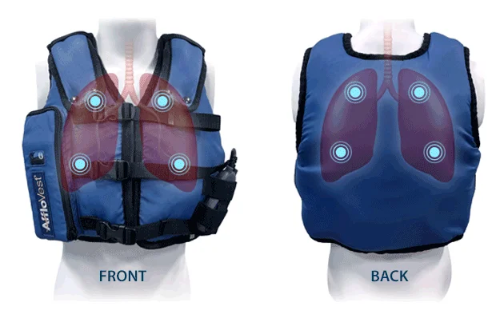Vest Therapy (HFCWO)
High Frequency Chest Wall Oscillation therapy for effective secretion clearance in patients with cystic fibrosis, COPD, and other respiratory conditions.
Understanding Vest Therapy
High Frequency Chest Wall Oscillation (HFCWO), commonly known as vest therapy, is an advanced airway clearance technique that uses gentle, rapid vibrations to help loosen and mobilize mucus from the lungs. This therapy is particularly beneficial for patients with conditions that cause thick, sticky secretions that are difficult to clear naturally.
The therapy involves wearing an inflatable vest connected to an air pulse generator that creates rapid pressure changes around the chest wall. These oscillations create airflow within the lungs that helps dislodge mucus, making it easier to cough up and clear from the airways. VeroHealth provides comprehensive vest therapy services including equipment fitting, training, and ongoing support to ensure optimal treatment outcomes.

Conditions Treated with Vest Therapy
Cystic Fibrosis
Manages thick, sticky secretions typical of CF using vest therapy
Bronchiectasis
Clears infected mucus from damaged airways and prevents reinfection
COPD with Chronic Bronchitis
Clears mucus build-up in chronic bronchitis, easing airway flow
Neuromuscular Disorders
Supports airway clearance when muscle weakness reduces cough strength
How Vest Therapy Works
1. Vest Application
The patient wears an inflatable vest that fits snugly around the chest and connects to an air pulse generator via flexible tubing.
2. Oscillation Generation
The generator creates rapid air pulses that inflate and deflate the vest at frequencies between 5–25 Hz, creating gentle chest wall oscillations.
3. Airflow Creation
The oscillations create small, rapid changes in airflow within the lungs, generating forces that help dislodge mucus from airway walls.
4. Mucus Mobilization
Loosened secretions move toward larger airways where they can be more easily coughed up and expelled from the lungs.
Advanced Vest Therapy Systems
VeroHealth provides state-of-the-art vest therapy systems with advanced features designed for comfort, effectiveness, and ease of use.
Adjustable Frequency & Pressure
Customizable oscillation frequency (5–25 Hz) and pressure settings to optimize therapy for individual patient needs and comfort levels.
Programmable Timers
Built-in timers with customizable treatment durations and automatic pause intervals for coughing and expectoration.
Multiple Vest Sizes
Comprehensive range of vest sizes from pediatric to adult extra-large, ensuring proper fit and optimal therapy effectiveness.
Quiet Operation
Advanced noise reduction technology allows for comfortable therapy sessions without disrupting daily activities or sleep.
Portable Design
Compact, lightweight systems that can be easily transported for therapy sessions at home, work, or while traveling.
Usage Tracking
Built-in compliance monitoring and usage tracking to help patients and healthcare providers monitor therapy adherence.
Treatment Protocols & Guidelines
Standard Treatment Session
- Duration: 15–30 minutes per session
- Frequency: 1–4 times daily as prescribed
- Oscillation Rate: 12–15 Hz
- Pressure: Adjusted for comfort
Most patients begin with standard settings and adjust based on comfort and effectiveness under clinical guidance.
Pediatric Considerations
- Age Range: Typically 2+ years
- Session Length: 10–20 minutes
- Frequency: 8–12 Hz
- Supervision: Adult required
Pediatric protocols are adjusted for smaller patients with special attention to comfort and safety.
Advanced Protocols
- Variable Frequency: Alternating modes
- Combination Therapy: Nebulizer compatible
- Positioning: Various lung positions
- Breathing Techniques: Coordinated steps
Advanced protocols are recommended for patients with complex conditions or specific goals.
Comprehensive Patient Support
In-Home Setup & Fitting
Professional vest fitting and equipment setup in your home with comprehensive training on proper use and maintenance procedures.
Clinical Assessment
Regular assessment by certified respiratory therapists to optimize therapy settings and ensure maximum effectiveness.
24/7 Clinical Support
Round-the-clock access to respiratory therapists for questions, troubleshooting, and clinical guidance related to your vest therapy.
Equipment Maintenance
Regular maintenance services and replacement of worn components to ensure your vest system continues to operate effectively.
Patient & Family Education
Comprehensive education for patients and caregivers on therapy techniques, equipment care, and strategies to maximize treatment benefits.
Therapy Monitoring
Regular monitoring of therapy compliance and effectiveness with adjustments made in coordination with your healthcare team.
Getting Started with Vest Therapy
Medical Evaluation
Your physician will evaluate your respiratory condition and determine if vest therapy is appropriate based on your diagnosis and secretion clearance needs.
Prescription & Authorization
Your doctor will provide a prescription for vest therapy, and our team will work with your insurance to obtain necessary authorizations.
Vest Fitting
A certified respiratory therapist will visit your home to properly fit your vest and ensure optimal comfort and therapy effectiveness.
Training & Education
Comprehensive training on equipment operation, treatment protocols, maintenance, and troubleshooting for you and your caregivers.
Ongoing Support
Continuous support including regular follow-ups, therapy optimization, equipment maintenance, and 24/7 clinical assistance.
Frequently Asked Questions
Ready to Learn More About Vest Therapy?
Our respiratory specialists are here to answer your questions and help you understand how vest therapy can improve your respiratory health and quality of life.
